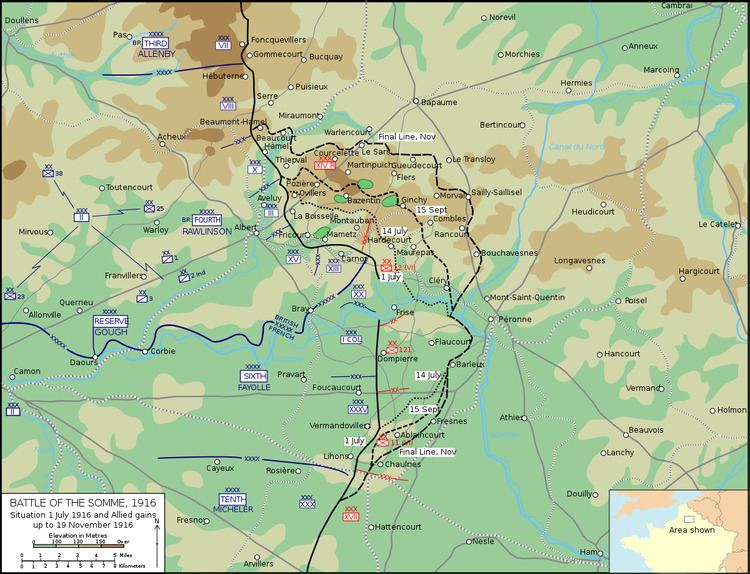623,907 c. 237,000–500,000 | ||
 | ||
13 British, 11 French divisions 1 July
51 British, 48 French divisions July–November 10 ⁄2 divisions 1 July
50 divisions July–November | ||
This is the order of battle for the Battle of the Somme. The Battle of the Somme was an offensive fought on the Western Front during World War I from 1 July to 18 November 1916 as one of the greatest engagements of the war. It was fought between French, British and Dominion forces and the German Empire in the Somme River valley and vicinity in northern France.
Contents
- British and Dominion forces
- Army structures
- Corps structures
- Formations per Battle
- Battle of Albert 113 July
- Battle of Bazentin Ridge 1417 July
- Battle of Pozires 23 July 3 September
- Battle of Flers Courcelette 1522 September
- Battle of Morval 2528 September
- Battle of le Transloy 118 October
- Battle of Ancre Heights 118 October
- Battle of the Ancre 1316 November
- Royal Flying Corps
- French forces
- Army and corps organisation
- Infantry Divisions
- Cavalry Divisions
- German Forces 2nd Army
- References
British and Dominion forces
In typical British county regiments, the 1st and 2nd Battalions were regular army, the 3rd was the special reserve battalion which did not normally serve overseas but remained at home as the regimental depot and training unit from which replacements were sent to the regular battalions. The 4th, 5th and 6th Battalions were normally Territorial Force battalions. Territorial battalions raised second line battalions which would be numbered 2/4th, 2/5th and 2/6th, initially from men who did not volunteer for overseas service. The terms of service in the Territorial Force meant that men who had signed up on these could not be forced to serve outside the United Kingdom. The number of battalions depended on the recruitment potential of the area from which the battalions were raised (i.e. the Dorsetshire Regiment raised eleven battalions, whilst the London Regiment managed to raise eighty-eight battalions).
Regular Army Divisions were numbered 1st to 8th. "New Army" divisions raised by the Kitchener recruitment drive were numbered 9th to 26th. The 27th to 29th Divisions were Regular Army divisions made up from units recalled from Imperial Garrison Duties. The 30th to 41st were again made up from New Army units while the 42nd to 74th were Territorial. The 63rd Division (Royal Naval Division) was made up from Naval Reserves and did not follow this numbering pattern.
Army structures
Corps structures
French 6th Army Corps, which contained British or Dominion forces:
Formations per Battle
Refer following section titled "Divisions" for brigades, regiments and battalions associated with each division participating in the listed battles. Battle nomenclature and participating units information taken from source British Army Council Command Notice 1138 unless stated otherwise:
Battle of Albert: 1–13 July
Subsidiary Attack at Gommecourt Salient: 1 July
Battle of Bazentin Ridge: 14–17 July
Subsidiary attack at Fromelles: 19 July
Subsidiary Attacks on High Wood: 20–25 July
Battle of Pozières: 23 July – 3 September
Battle of Flers-Courcelette: 15–22 September
Battle of Morval: 25–28 September
Battle of le Transloy: 1–18 October
Battle of Ancre Heights: 1–18 October
Battle of the Ancre: 13–16 November
Royal Flying Corps
French forces
A majority of the French Divisions were triangular divisions – that is comprising three regiments, with each regiment containing three battalions.
During the Battle of Verdun, General Pétain had rotated the French Divisions through the battle – resulting in a large number of divisions entering the battle with experience.
Army and corps organisation
List of Army/Corp/Divisions involved taken from Organigramme des Grandes Batailles.
Army structures
Corps structures
(Note: That a majority of the Corps/Divisions were rotated in from other Armies as the battle progressed.)
Infantry Divisions
1st Infantry Division
2nd Infantry Division
3rd Infantry Division
4th Infantry Division
10th Infantry Division
11th Infantry Division
12th Infantry Division
13th Infantry Division
14th Infantry Division
17th Infantry Division
18th Infantry Division
20th Infantry Division
25th Infantry Division
26th Infantry Division
39th Infantry Division
41st Infantry Division
42nd Infantry Division
43rd Infantry Division
45th Infantry Division
46th Infantry Division
47th Infantry Division
48th Infantry Division
51st Infantry Division
53rd Infantry Division
56th Infantry Division
61st Infantry Division
62nd Infantry Division
66th Infantry Division
70th Infantry Division
72nd Infantry Division
77th Infantry Division
120th Infantry Division
121st Infantry Division
125th Infantry Division
127th Infantry Division
132nd Infantry Division
152nd Infantry Division
153rd Infantry Division
Moroccan Infantry Division
2nd Colonial Infantry Division
3rd Colonial Infantry Division
10th Colonial Infantry Division
15th Colonial Infantry Division
16th Colonial Infantry Division
Cavalry Divisions
1st Cavalry Division
2nd Cavalry Division
3rd Cavalry Division
4th Cavalry Division
German Forces: 2nd Army
All German order of battle derived from Hart, Appendix C unless stated otherwise.
German Army Group Commander: von Gallwitz
Commander: General der Infanterie Fritz von Below
Chiefs of Staff: General Erich Falkenhayn (until 28 August 1916), General Paul von Hindenburg
At this time, German Divisions were in the process of being converted from square to triangular, hence some had four infantry regiments, others had three.
